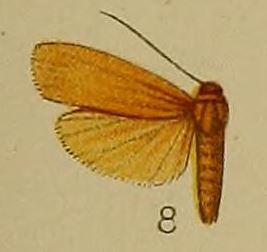
Hemonia is a genus of moths in the family Erebidae first described by Francis Walker in 1863. They are found only in Sri Lanka and Borneo.

Eublemma anachoresis, the banner, is a moth of the family Erebidae. The species was first described by Hans Daniel Johan Wallengren in 1863. It is found in the Indomalayan realm, Australia and the southern part of Africa. Records include Fiji, Hong Kong, India, Sri Lanka, Japan, the Society Islands, Eswatini, Taiwan, Thailand and northern New South Wales and Queensland in Australia.

Arrade is a genus of moths of the family Erebidae described by Francis Walker in 1863.
Trischalis is a genus of moths in the family Erebidae erected by George Hampson in 1894.

Gyrtona is a genus of moths of the family Euteliidae first described by Francis Walker in 1863.
Olulis is a genus of moths of the family Noctuidae first described by Francis Walker in 1863.

Derambila is a genus of moths in the family Geometridae first described by Francis Walker in 1863.

Berta chrysolineata is a species of moth of the family Geometridae described by Francis Walker in 1863. It is widespread from the Indo-Australian tropics of India, Sri Lanka to the Solomons.

Lamoria is a genus of small moths belonging to the family Pyralidae.
Praeacedes is a monotypic moth genus in the family Tineidae first described by Hans Georg Amsel in 1954. Its only species, Praeacedes atomosella, was first described by Francis Walker in 1863. It has a wide range and has been recorded from Europe, Australia, Hawaii, India, Malaysia, Solomon Islands, Easter Island, Mauritius, Madagascar, Réunion, South America and North America. The species has commonly been misidentified in various parts of the world.

Brunia antica is a moth of the family Erebidae described by Francis Walker in 1854. It is found from the Indian subregion, Sri Lanka to China, the Ryukyu Islands, the Chagos Archipelago, the Nicobar Islands and Sundaland.

Scirpophaga incertulas, the yellow stem borer or rice yellow stem borer, is a species of moth of the family Crambidae. It was described by Francis Walker in 1863. It is found in Afghanistan, Nepal, north-eastern India, Sri Lanka, Bangladesh, Myanmar, Vietnam, Thailand, Malaysia, Singapore, Sumatra, Java, Borneo, Sumba, Sulawesi, the Philippines, Taiwan, China and Japan.
Lamoria adaptella, the plain lamoria, is a species of snout moth in the genus Lamoria. It was described by Francis Walker in 1863 and is known from South Africa, the Gambia, Kenya, Mozambique, India, Sri Lanka, Indonesia and Singapore, as well as Japan and Taiwan.

Somena scintillans, the yellow tail tussock moth, is a moth in the family Erebidae described by Francis Walker in 1856. It is found in northern India, Sri Lanka, Myanmar and the Andaman Islands. Though considered a minor pest, larva can sporadically be a serious pest.
Ziridava xylinaria, the indistinct carpet, is a moth in the family Geometridae. The species was first described by Francis Walker in 1863. It is found in Sri Lanka, India, Hong Kong and on Peninsular Malaysia, Borneo, Java and possibly the Philippines and Sulawesi.
Narosodes punctana is a moth of the family Erebidae. It was described by Francis Walker in 1863. It is found in Sri Lanka and India and on Borneo.
Trischalis subaurana is a moth in the family Erebidae. It was described by Francis Walker in 1863. It is found in the Indo-Australian tropics, from the north-eastern Himalayas and Hainan, China to the Bismarck Archipelago. The habitat consists of forests, ranging from the lowlands to the lower montane zone at about 1,000 meters.

Olulis puncticinctalis is a moth of the family Noctuidae first described by Francis Walker in 1863. It is found in Borneo, Peninsular Malaysia, the Andaman Islands, India, Sri Lanka, Taiwan and Japan.

Autoba versicolor, the flower webber, sometimes included in the genus Eublemma, is a species of moth of the family Erebidae. It was described by Francis Walker in 1863, from material collected by Alfred Russel Wallace in Sarawak on the island of Borneo. It is the type species of its genus.

Margaroniini is a tribe of the species-rich subfamily Spilomelinae in the pyraloid moth family Crambidae. The tribe was erected by Charles Swinhoe and Everard Charles Cotes in 1889, originally as family Margaronidae.











